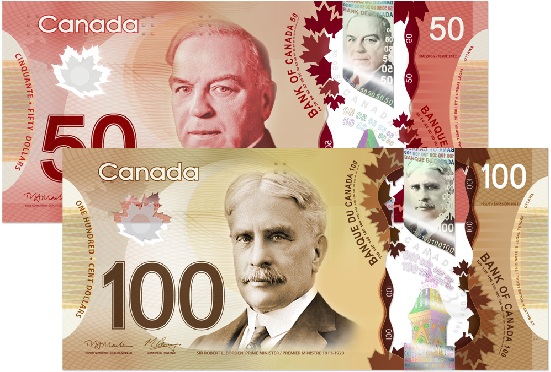Bank of Canada releases new bank notes, described as almost impossible to fake
By Daniel Kosir | June 29, 2011
Canada is finally making the switch from paper to polymer bank notes.
On June 20 the Bank of Canada unveiled the new $100 and $50 bank notes that it will be introducing in November 2011 and March 2012, respectively.
The polymer notes, described as all but impossible to fake, will also consist of $20, $10 and $5 bills, to be unveiled and issued by the end of 2013.
Polymer notes, which were pioneered and introduced in Australia about 20 years ago, are much harder to copy than their cotton-based counterparts, are more durable, and do not curl or fray at the corners. The Canadian notes are expected to be among the most secure in the world.
The main reason for the newer notes is security: by 2004, counterfeiting in Canada had reached a record high of 470 counterfeit notes detected per million. Though that number has since dropped to 35 notes detected per million, the Bank of Canada hopes to stay ahead of counterfeiting threats and lower this number even further.
Some new security features include:
- A metallic portrait of the Prime Minister on the bill;
- A large area from top to bottom containing a number of complex holographic features;
- Raised ink;
- Optical features that change colour when tilted under light;
- Ink that appears to change colours when viewed at different angles; and
- A holographic maple leaf with hidden numbers.

Safer, Cheaper, Greener
Besides security, there are other projected advantages to using the polymer notes. In a speech made at the bank's headquarters, Bank of Canada governor Mark Carney spoke of the financial and environmental perks of the new notes.
"We have independently verified that the environmental footprint of polymer notes will be smaller than that of currency made from cotton-based bank note paper," he said. "The new bills will last at least 2.5 times longer than cotton-based bank note paper bills, and after being removed from circulation, for the first time in Canada, they will be recycled into other products."
After the issuing of each bill, the Bank of Canada hopes to have as many older notes exchanged with newer ones as possible. Bank officials have said that the goal for the $20 bill, the most highly-circulated, is to have 70 to 80 per cent of the older notes out of circulation within 18 months of its release.
Detecting counterfeits
The following video, taken from the Bank of Canada website, provides tips on how to check if bills are real.
If you enjoyed this article, be sure to visit CanadaOne's article knowledge base for more informative articles.





